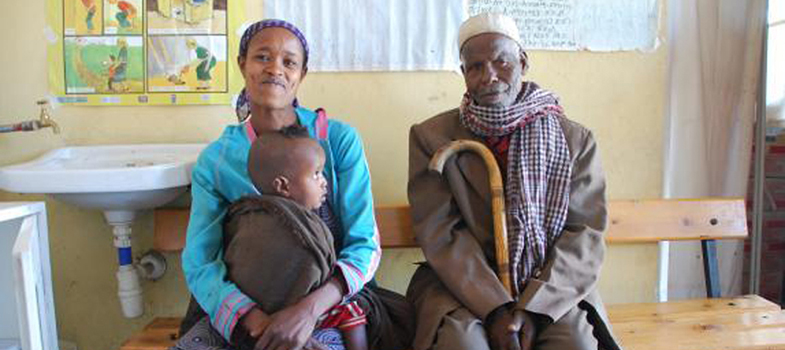Self-Assessment Questions (SAQs) for Study Session 3
Now that you have completed this study session you can assess how well you have achieved its Learning Outcomes by answering the following questions. Some of the question test the Learning Outcomes for Study Session 2, as well as those for Study Session 3. Write your answers in your Study Diary and discuss them with your Tutor at the next Study Support Meeting. You can check your answers with the notes on the Self-Assessment Questions at the end of this Module.
SAQ 3.1 (tests Learning Outcomes 2.1, 2.2, 3.1 and 3.2)
Classify each of the following vaccines as either antibacterial or antiviral (or both) by putting crosses in the appropriate columns of Table 3.6. Write the name of the diseases or conditions that each vaccine prevents in the last column of the table.
| Vaccine | Antibacterial | Antiviral | Protects against |
|---|---|---|---|
| BCG vaccine | |||
| Measles vaccine | |||
| Pentavalent vaccine | |||
| Yellow fever vaccine | |||
| Pneumococcal vaccine (PCV10) | |||
| OPV | |||
| TT vaccine | |||
| Meningococcal vaccine | |||
| Rotavirus vaccine |
Answer
The completed version of Table 3.6 appears below.
| Vaccine | Antibacterial | Antiviral | Protects against |
|---|---|---|---|
| BCG vaccine | X | Tuberculosis | |
| Measles vaccine | X | Measles | |
| Pentavalent vaccine | X (four components) | X (one component) | Diphtheria, pertussis, tetanus, Haemophilus influenzae type b meningitis and pneumonia, hepatitis B liver diseases |
| Yellow fever vaccine | X | Yellow fever | |
| Pneumococcal vaccine (PCV10) | X | Pneumococcal diseases (including pneumonia) | |
| OPV | X | Poliomyelitis | |
| TT vaccine | X | Neonatal tetanus (and tetanus in women) | |
| Meningococcal vaccine | X | Meningococcal meningitis | |
| Rotavirus vaccine | X | Diarrhoea and dehydration caused by rotaviruses |
SAQ 3.2 (tests Learning Outcome 3.3)
Summarise the dosage, route of administration and schedule for each of the current antiviral EPI vaccines used in Ethiopia by completing Table 3.7.
| Vaccine | Dosage and route | Schedule |
|---|---|---|
| HepB (as part of pentavalent vaccine) | ||
| OPV | ||
| Measles |
Answer
The completed version of Table 3.7 appears below.
| Vaccine | Dosage and route | Schedule |
|---|---|---|
| HepB (as part of pentavalent vaccine) | 0.5 ml, three intramuscular injections | At 6, 10 and 14 weeks |
| OPV | 2 drops, four oral doses | At birth, and 6, 10 and 14 weeks |
| Measles | 0.5 ml, one subcutaneous injection in the EPI, plus one campaign dose | At 9 months of age in the EPI; campaign dose after 12 months |
SAQ 3.3 (tests Learning Outcome 3.4)
Complete Table 3.8 to indicate the possible adverse events following immunization with OPV and measles vaccines, and their management at Health Post level.
| Vaccine | Adverse events | Management |
|---|---|---|
| OPV | ||
| Measles |
Answer
The completed version of Table 3.8 appears below.
| Vaccine | Adverse events | Management |
|---|---|---|
| OPV | None | None required |
| Measles | Mild rash Mild fever | None required Paracetamol syrup |
SAQ 3.4 (tests Learning Outcomes 2.3 and 3.3)
What immunizations (if any) should the following children be given? Assume that rotavirus vaccine has not yet been introduced.
- a.A newborn baby.
- b.A ten-month-old child who has had BCG, OPV3, PCV3 and Penta3.
- c.An eight-month-old child who has had BCG, OPV3, PCV3 and Penta3.
- d.A six-week-old child who has had BCG and OPV0.
Answer
The immunizations (if any) that these individuals should receive are as follows:
- a.A newborn baby should be given BCG and OPV0.
- b.A ten-month-old child who has had BCG, OPV3, PCV3 and Penta3 should be given measles vaccine.
- c.An eight-month-old child who has had BCG, OPV3, PCV3 and Penta3 should not be given any further vaccinations until he or she is 9 months old, when measles vaccine should be given.
- d.A six-week-old child who has had BCG and OPV0 should be given OPV1, PCV1 and Penta1.
SAQ 3.5 (tests Learning Outcomes 2.5 and 3.5)
Fatima’s grandmother brings her to your Health Post when she is ten weeks old for OPV2, PCV2 and Penta2. Three days later, Fatima becomes very ill and develops a severe allergic reaction. After a brief period of hospitalisation, she recovers fully. When Fatima is 14 weeks old, her grandmother brings her to see you at an immunization clinic. She has a mild episode of diarrhoea at the time.
- a.What vaccines (if any) should you give Fatima?
- b.What should you explain to Fatima’s grandmother?
Answer
- a.Immunize Fatima with OPV3; it is safe to give this vaccine even though she has mild diarrhoea. But do not give her PCV3 or Penta3 because she developed a severe allergic reaction three days after the earlier immunization, which may have been an adverse vaccine reaction following immunization with one of these vaccines. It is very unlikely to have been due to the previous dose of OPV.
- b.Explain to the grandmother that it is safe for Fatima to have another dose of OPV, and why you are not giving the child another dose of the other two vaccines. Tell the grandmother to come back after another four weeks; because of the diarrhoea Fatima has today, she will need an extra (fifth) dose of OPV in four weeks’ time.
Summary of Study Session 3
